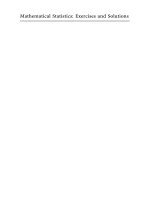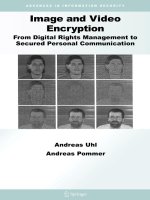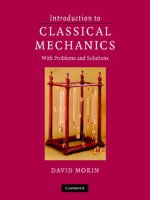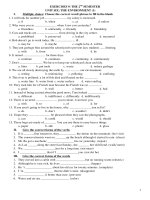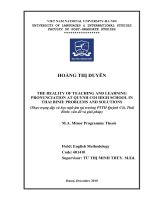Mortad, mohammed hichem introductory topology exercises and solutions world scientific (2017)
Bạn đang xem bản rút gọn của tài liệu. Xem và tải ngay bản đầy đủ của tài liệu tại đây (6.47 MB, 375 trang )
111111111| | | | | | | l l l > I I M
INTRODUCTORY
TOPOLOGY
Exercises and Solutions
S e c o n d Edition
IN T R O D U C T O R Y
TOPOLOGY
Exercises and Solutions
Second Edition
This page intentionally left blank
INTRODUCTORY
TOPOLOGY
Exercises and Solutions
Second Edition
Mohammed Hichem Mortad
University of Oran 1, Ahmed Ben Bella, Algeria
World Scientific
NEW JERSEY • LONDON • SINGAPORE • BEIJING • SHANGHAI • HONG KONG • TAIPEI • CHENNAI
Published by
World Scientific Publishing Co. Pte. Ltd.
5 Toh Tuck Link, Singapore 596224
USA office: 27 Warren Street, Suite 401-402, Hackensack, NJ 07601
UK office: 57 Shelton Street, Covent Garden, London WC2H 9HE
Library o f Congress Cataloging-in-Publication Data
Names: Mortad, Mohammed Hichem, 1978-
Title: Introductory topology : exercises and solutions / by Mohammed Hichem Mortad
(University o f Oran, Algeria).
Description: 2nd edition. |New Jersey : World Scientific, 2016. |
Includes bibliographical references and index.
Identifiers: LCCN 2016030117 |ISBN 9789813146938 (hardcover : alk. paper) |
ISBN 9789813148024 (pbk : alk. paper)
Subjects: LCSH: Topology—Problems, exercises, etc.
Classification: LCC QA611 .M677 2016 |DDC 514.076«dc23
LC record available at />
British Library Cataloguing-in-Publication Data
A catalogue record for this book is available from the British Library.
Copyright © 2017 by World Scientific Publishing Co. Pte. Ltd.
A ll rights reserved. This book, or parts thereof, may not be reproduced in anyform or by any means,
electronic or mechanical, including photocopying, recording or any information storage and retrieval
system now known or to be invented, without written permission from the Publisher.
For photocopying o f material in this volume, please pay a copying fee through the Copyright Clearance
Center, Inc., 222 Rosewood Drive, Danvers, M A 01923, USA. In this case permission to photocopy
is not required from the publisher.
Printed in Singapore
Contents
Preface ix
Preface to the Second Edition xiii
Notation and Terminology XV
0.1. Notation XV
0.2. Terminology xvi
Part 1. Exercises 1
Chapter 1. General Notions: Sets, Functions et al. 3
1 .1 . Essential Background 3
1 .1 .1 . Sets 3
1.1.2. Functions 9
1.1.3. Equivalence Relation 15
1.1.4. Consequences of The Least Upper Bound Property 15
1.1.5. Countability 17
1.2. Exercises With Solutions 19
1.3. More Exercises 24
Chapter 2. Metric Spaces 27
2.1. Essential Background 27
2.1.1. Definitions and Examples 27
2.1.2. Important Sets in Metric Spaces 30
2.1.3. Continuity in Metric Spaces 32
2.1.4. Equivalent Metrics 34
2.2. True or False: Questions 36
2.3. Exercises With Solutions 36
2.4. Tests 42
2.5. More Exercises 43
Chapter 3. Topological Spaces 47
3.1. Essential Background 47
3.1.1. General Notions 47
3.1.2. Separation Axioms 49
3.1.3. Closures, Interiors, Limits Points, et al 50
v
VI CONTENTS
3.1.4. Bases and Subbases 56
3.1.5. The Subspace Topology 58
3.1.6. The Product and Quotient Topologies 59
3.2. True or False: Questions 61
3.3. Exercises With Solutions 63
3.4. Tests 72
3.5. More Exercises 73
Chapter 4. Continuity and Convergence 77
4.1. Essential Background 77
4.1.1. Continuity 77
4.1.2. Convergence 82
4.1.3. Sequential Continuity 83
4.1.4. A Word on Infinite Product Topology 84
4.2. True or False: Questions 86
4.3. Exercises With Solutions 87
4.4. Tests 94
4.5. More Exercises 95
Chapter 5. Compact Spaces 99
5.1. Essential Background 99
5.1.1. Compactness: General Notions 99
5.1.2. Compactness and Continuity 102
5.1.3. Sequential Compactness and Total Boundedness 104
5.2. True or False: Questions 106
5.3. Exercises With Solutions 107
5.4. Tests 112
5.5. More Exercises 113
Chapter 6. Connected Spaces 117
6.1. Essential Background 117
6.1.1. Connectedness 117
6.1.2. Components 119
6.1.3. Path-connectedness 120
6.2. True or False: Questions 122
6.3. Exercises With Solutions 123
6.4. Tests 125
6.5. More Exercises 126
Chapter 7. Complete Metric Spaces 129
7.1. Essential Background 129
7.1.1. Completeness 129
7.1.2. Fixed Point Theorem 135
CONTENTS vii
7.1.3. A Word on Integral Equations 137
7.2. True or False: Questions 140
7.3. Exercises With Solutions 141
7.4. Tests 148
7.5. More Exercises 148
Chapter 8. Function Spaces 153
8.1. Essential Background 153
8.1 .1 . Types of Convergence 153
8.1 .2. Weierstrass Approximation Theorem 155
8.1.3. The Arzela-Ascoli Theorem 155
8.2. True or False: Questions 157
8.3. Exercises With Solutions 157
8.4. Tests 159
8.5. More Exercises 159
Part 2. Solutions 161
Chapter 1. General Notions: Sets,Functions et al 163
1 .2. Solutions to Exercises 163
Chapter 2. Metric Spaces 181
2.2. True or False: Answers 181
2.3. Solutions to Exercises 183
2.4. Hints/Answers to Tests 201
Chapter 3. Topological Spaces 203
3.2. True or False: Answers 203
3.3. Solutions to Exercises 209
3.4. Hints/Answers to Tests 241
Chapter 4. Continuity and Convergence 243
4.2. True or False: Answers 243
4.3. Solutions to Exercises 247
4.4. Hints/Answers to Tests 266
Chapter 5. Compact Spaces 269
5.2. True or False: Answers 269
5.3. Solutions to Exercises 272
5.4. Hints/Answers to Tests 293
Chapter 6. Connected Spaces 295
6.2. True or False: Answers 295
6.3. Solutions to Exercises 298
6.4. Hints/Answers to Tests 307
viii CONTENTS
Chapter 7. C o m p le te M e tr ic Spaces 309
7.2. True or False: Answers 309
7.3. Solutions to Exercises 313
7.4. Hints/Answers to Tests 342
Chapter 8. F u n ction Spaces 343
8.2. True or False: Answers 343
8.3. Solutions to Exercises 345
8.4. Hints/Answers to Tests 350
Bibliography 351
Index 353
Preface
Topology is a major area in mathematics. At an undergraduate
level, at a research level, and in many areas of mathematics (and even
outside of mathematics in some cases), a good understanding of the
basics of the theory of general topology is required. Many students
find the course nTopologyn (at least in the beginning) a bit confusing
and not too easy (even hard for some of them) to assimilate. It is like
moving to a different place where the habits are not as they used to be,
but in the end we know that we have to live there and get used to it.
They are usually quite familiar with the real line R and its properties.
So when they study topology they start to realize that not everything
true in M needs to remain true in an arbitrary topological space. For in
stance, there are convergent sequences which have more than one limit,
the identity mapping is not always continuous, a normally convergent
series need not converge (although the latter is not within the scope of
this book). So in many references, they use the word "usual topology
of R ", a topology in which things are as usual! while there are many
other "unusual topologies" where things are not so "usual"!
The present book offers a good introduction to basic general topol
ogy throughout solved exercises and one of the main aims is to make
the understanding of topology an easy task to students by proposing
many different and interesting exercises with very detailed solutions,
something that it is not easy to find in another manuscript on the same
subject in the existing literature. Nevertheless, and in order that this
books gives its fruits, we do advise the reader (mainly the students) to
use the book in a clever way inasmuch as while the best way to learn
mathematics is by doing exercises, the worst way of doing exercises is to
read the solution without thinking about how to solve the exercises (at
least for some time). Accordingly, we strongly recommend the student
to attempt the exercises before consulting the solutions. As a Chinese
proverb says: If you give someone a fish, then you have given him to
eat for one day, but if you teach him how to fish, then you have given
him food for everyday. So we hope the students are going to learn to
"fish" using this book.
IX
X PREFACE
The present manuscript is mainly intended for an undergraduate
course in general topology. It does not include algebraic and geometric
topologies. Other topics such as: nets, topologies of infinite products,
quotient topology, first countability, second countability and the T*
separation axioms with i = 0,3,4, 5 are not considered neither or are
not given much attention. It can also be used by instructors and anyone
who needs the basic tools of topology. Teaching this course several
times with many different exercises each year has allowed me to collect
all the exercises given in this book. I relied on many references (I
cannot remember all of them but most of them can be found in the
bibliography) in lectures and tutorials. If there is some source which I
have forgotten to mention, then I sincerely apologize for that. Let us
now say a few words about the contents of this book. The exercises on
the subjects covered in this book can be used for a one semester course
of 14-15 weeks.
The book is divided into two parts. In Part 1, each chapter (except
for the first one) contains five sections. They are:
(1) What You Need t o Know: (which has become "Essential Back
ground" in the new editions) In this part, we recall the essential
of notions and results which are needed for the exercises. No
proofs are given directly. The reader may also wish to consult
the following references for further reading: [1], [4], [6], [12],
[16], [18], [19], [20], [25], [26], [28] and [29],
(2) True or F a lse: In this part some interesting questions are
proposed to the reader. They also contain common errors
which appear with different students almost every year. Thanks
to this section, students should hopefully avoid making many
silly mistakes. This part is an important back-up for the
"What You Need to Know" section. Readers may even find
some redundancy, but this is mainly because it is meant to
test their understanding.
(3) E x ercises with S o lu tio n s: The major part and the core
of each chapter where many exercises are given with detailed
solutions.
(4) T e s t s : This section contains short questions given with just
answers or simply hints.
(5) More E x e rcise s: In this part some unsolved exercises are pro
posed to the interested reader.
In Part 2, the reader finds answers to the questions appearing in the
section "True or False" as well as solutions to Exercises and Tests.
PREFACE xi
The prerequisites to use this book are basics of: functions of one
variable (some of the several variables calculus is also welcome), se
quences and series.
Since the terminology in topology is rich and may be different from
a book to another, we do encourage the readers to have a look at the
nNotations and Terminology” chapter to avoid an eventual confusion
or ambiguity with symbols and notations.
Before finishing, I welcome and I will be pleased to receive any sug
gestions, questions (as well as pointing out eventual errors and typos)
from readers at my email:
Last but not least, thanks are due in particular to Dr Lim Swee
Cheng and Ms Tan Rok Ting, and all the staff of World Scientific
Publishing Company for their patience and help.
Oran on September the 24th, 2013,
Mohammed Hichem Mortad
The University of Oran (Algeria).
This page intentionally left blank
Preface to the Second Edition
In this second edition, many changes have been made, some quite
significant. For instance, this new edition contains proofs (as exercises)
of many results in the old section "What You Need To Know", which
has been renamed here as "Essential Background". This new edition
has also many additional exercises.
There is another improvement still about the section "Essential
Background". Indeed, it has been considerably beefed up as it now in
cludes more remarks and results for readers’ convenience. As an illus
trative point, we have enlarged the subsection "Fixed Point Theorem"
and even added one on applications to integral equations.
I have also added other notions e.g. on the topology of an arbitrary
product of topological spaces as well as separation axioms. Despite
all these changes, the book still does not cover concepts of Algebraic
Topology.
The sections "True or False" and "Tests" have remained as they
were apart from a very few changes.
I have also corrected typos and mistakes which appeared in the
earlier edition of this manuscrit.
It is worth noticing that some of these points were suggested in the
MAA review by Dr Mark Hunacek. I take this opportunity to thank
him for his review.
Readers wishing to contact me may do that via my email:
Finally, warm thanks are due to all the staff of World Scientific
Publishing Company for their patience and help (in particular, Dr Lim
Swee Cheng and Ms Tan Rok Ting).
Oran, Algeria
M ay 08, 2016
Prof. Dr M . H. Mortad
xm
This page intentionally left blank
Notation and Terminology
0.1. Notation
• N is the set of natural numbers, i.e. N is the set { 1 , 2, •••}
(note that the French N contains 0 too).
• Z is the set of all integers while Z + is the set of positive inte
gers.
• Q is the set of rational numbers.
• R is the set of real numbers.
• C is the set of complex numbers.
• [a, b] is the closed interval with endpoints a and b.
• (a, b) is the open interval with endpoints a and b.
• The power set of set X is denoted by V (X ) or 2X .
• (a, b) also denotes an ordered pair.
• i the complex square root of —1 .
• x 1-)- ex the usual exponential function.
• The complement of a set A in X is often denoted by Ac and
occasionally it is denoted by X \ A or X —{a }.
• The empty set is denoted by 0 .
• d(x, A) is the distance between a point x in X to a set A C X
where (X , d) is a metric space.
• d(A) is the diameter of a set A in a metric space (X , d).
• In a metric space (X, d), the open ball of radius r > 0 and
center x E X is denoted by B (x,r).
• In a metric space (X ,d), the closed ball of radius r > 0 and
center x E X is denoted by Bc(x,r).
• In a metric space (X , d), the sphere of radius r > 0 and center
x G X is denoted by S (x,r).
o
• The interior of a set A in a topological space is denoted by A.
• The closure of a set A in a topological space is denoted by A.
• A f denotes the derived set of A , that is the set of limit points
of A (where A is a subset of a topological space X ).
• The frontier of a set is denoted by Fr or d.
• card denotes the cardinal of a set.
XV
XVI NOTATION AND TERMINOLOGY
• R^ is the lower limit topology.
• Mx is the if-topology.
• The set of neighborhoods of a point x G X , where X is a
topological space, is denoted by Af(x).
• Cx denotes the (connected) component of x E X where X is
a topological space.
• The real part of a complex number is denoted by Re.
• The imaginary part of a complex number is denoted by Im.
• The conjugate of a complex number z is denoted by z.
• C ([0, 1]) (or C ([0, 1],R )) is the space of real-valued continuous
functions on [0,1] taking values in R. If the field of values is
C, then this will be clearly mentioned.
• C,1([0 ,1]) (or C 1([0 ,1], R)) is the space of real-valued contin
uous functions defined on [0, 1], differentiable and having a
continuous derivative.
• (R, |•|) is R equipped with the standard or the usual metric,
i.e. the absolute value function.
0.2. Terminology
• There is a general comment which should be remembered by
the reader. Except in the sections "True or False", if we say
R (or any subset of it) without specifying the topology or the
metric, then this means R endowed with its usual topology or
metric. This applies to C, R n and C n too.
• It will be comprehensible from the context whether "c" is for
comparing two sets or two topologies.
• It will be clear from the context whether (a, b) is the ordered
pair or the open interval.
• When it is not too important to specify the metric or the
topology, we simply say the topological (or metric) space X .
• From time to time the reader will see "(w hy?)". In such case,
this means that this is a question whose answer should be
known by the reader. This is used by other authors such as
J. B. Conway (see [7]) and also M. Stoll (see [28]). Other
expressions such as "(is it not?)" are also used.
• The letters "w.r.t." stand for "with respect to".
• As it is used almost everywhere, "iff" means "if and only if".
For the fun, the French use "ssi" for "si et seulement si". Even
in Arabic, it has been sorted out by doubling a letter in the
end!
0.2. TERMINOLOGY X V II
As "iff” , there are other words which cannot be found in an
English language dictionary but we still use them. For exam
ple, "Cauchyness", "Hausdorffness", "clopen", etc...
W LOG, as it pleases many, stands for "without loss of gener
ality" .
If readers see in the end of an answer "•••", then this means
that details are left to them.
This page intentionally left blank
Part 1
Exercises

